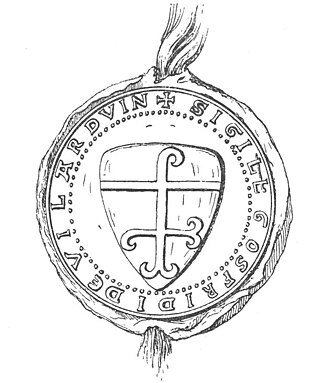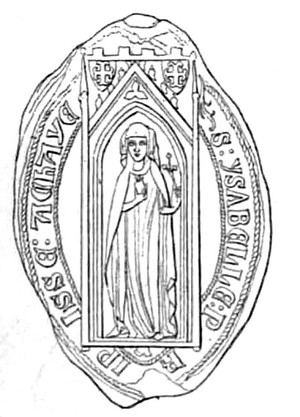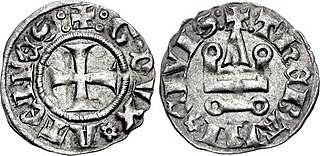Related Research Articles

The Principality of Achaea or Principality of Morea was one of the vassal states of the Latin Empire, which replaced the Byzantine Empire after the capture of Constantinople during the Fourth Crusade. It became a vassal of the Kingdom of Thessalonica, along with the Duchy of Athens, until Thessalonica was captured by Epirus in 1224. After this, Achaea became the dominant power in Greece, lasting continuously for 227 years and cumulatively for 229.

William of Villehardouin was the fourth prince of Achaea in Frankish Greece, from 1246 to 1278. The younger son of Prince Geoffrey I, he held the Barony of Kalamata in fief during the reign of his elder brother Geoffrey II. William ruled Achaea as regent for his brother during Geoffrey's military campaigns against the Greeks of Nicaea, who were the principal enemies of his overlord, the Latin Emperor of Constantinople Baldwin II. William succeeded his childless brother in the summer of 1246. Conflicts between Nicaea and Epirus enabled him to complete the conquest of the Morea in about three years. He captured Monemvasia and built three new fortresses, forcing two previously autonomous tribes, the Tzakones and Melingoi, into submission. He participated in the unsuccessful Egyptian crusade of Louis IX of France, who rewarded him with the right to issue currency in the style of French royal coins.

William I of Champlitte (1160s-1209) was a French knight who joined the Fourth Crusade and became the first prince of Achaea (1205–1209).

Geoffrey I of Villehardouin was a French knight from the County of Champagne who joined the Fourth Crusade. He participated in the conquest of the Peloponnese and became the second prince of Achaea.

Philip I, known as Philip of Savoy was the lord of Piedmont from 1282 until his death and prince of Achaea between 1301 and 1307. He was the son of Thomas III of Piedmont and Guia of Burgundy.

Isabella of Villehardouin was reigning Princess of Achaea from 1289 to 1307. She was the elder daughter of Prince William II of Achaea and of his third wife, Anna Komnene Doukaina, the second daughter of Michael II Komnenos Doukas, the despot of Epiros.

Othon de la Roche, also Otho de la Roche, was a Burgundian nobleman of the De la Roche family from La Roche-sur-l'Ognon. He joined the Fourth Crusade and became the first Frankish Lord of Athens in 1204. In addition to Athens, he acquired Thebes by around 1211.
Guy I de la Roche (1205–1263) was the Duke of Athens, the son and successor of the first duke Othon. After the conquest of Thebes, Othon gave half the city in lordship to Guy.
John I de la Roche succeeded his father, Guy I, as Duke of Athens in 1263. He was cultured and chivalrous, spoke fluent Greek, and read Herodotus.

Guy II de la Roche, also known as Guyot or Guidotto, was the Duke of Athens from 1287, the last duke of his family. He succeeded as a minor on the death of his father, William I, at a time when the duchy of Athens had exceeded the Principality of Achaea in wealth, power, and importance.

The Battle of Makryplagi or Makry Plagi was fought between the forces of the Byzantine Empire, and the Latin Principality of Achaea. The Byzantines had been weakened and demoralized by the defection of their numerous Turkish mercenaries to the Achaeans. At Makryplagi, the Byzantines suffered a heavy defeat, which together with their defeat at the Battle of Prinitza the previous year ended their attempted reconquest of the Morea.
Otho of Saint Omer was the lord of half of Thebes in Frankish Greece from 1294 to ca. 1299.
Guy of Charpigny was the second Baron of Vostitsa in the Principality of Achaea in Frankish Greece.
Geoffrey of Briel, in older literature Geoffrey of Bruyères, was a French knight and the third lord of the Barony of Karytaina in the Principality of Achaea, in Frankish Greece. He led a colourful and turbulent life, narrated in detail in the Chronicle of the Morea. Accounted the finest knight in the Principality, he fought in the wars against the Byzantine Greeks, was captured in the Battle of Pelagonia in 1259, and was sent back to Achaea bearing the Byzantine terms in 1261. Geoffrey was twice deprived of his barony, once for rebelling against his uncle, the Prince of Achaea William II of Villehardouin, and then for abandoning the Principality without leave in order to spend time with a mistress, the wife of one of his feudatories, in Italy. He was pardoned both times, but henceforth held his title as a gift of the Prince. He died childless in 1275, and the Barony of Karytaina was split up.
The First Parliament of Ravennika was convened in May 1209 by Latin Emperor Henry of Flanders in the town of Ravennika in Central Greece in an attempt to resolve the rebellion of the Lombard barons of the Kingdom of Thessalonica.
The Second Parliament of Ravennika was convened in May 1210 by Latin Emperor Henry of Flanders in the town of Ravennika in Central Greece in order to resolve the differences between the princes of Frankish Greece and the Roman Catholic clergy of their domains.
Helena Angelina Komnene was a daughter of the Greek sebastokrator John I Doukas, ruler of Thessaly in ca. 1268–1289, and a Greek princess of Aromanian origin, known only by her monastic name, Hypomone.
Carintana dalle Carceri was the triarch of the northern third (Oreus) of the Lordship of Negroponte in Frankish Greece in c. 1220–1255.
Narzotto dalle Carceri was the ruler of the southern terziere, or third, of the Lordship of Negroponte in Frankish Greece from 1247 to 1264. He married Felisa, a daughter of William I of Verona.
The bailli, bailie, or bailiff was the administrative representative of the Princes of Achaea, ruling the Principality of Achaea in the Prince's absence. The early princes, who belonged to the founding Villehardouin dynasty, resided in the principality, and governed it directly. In 1278, Achaea passed to Charles of Anjou, the King of Naples. Charles, and many of his successors, ruled the principality through their baillis, and never visited it in person. Originally, the baillis were Angevin officials, but the post was often given to powerful feudatories from Achaea and the rest of Frankish Greece.
References
- ↑ Longnon 1969, p. 245.
- ↑ Lock 1995, p. 173.